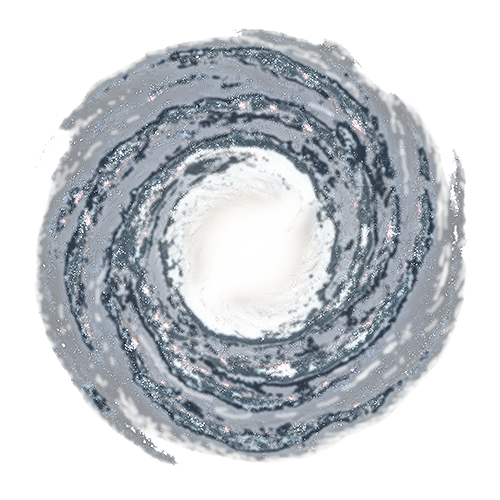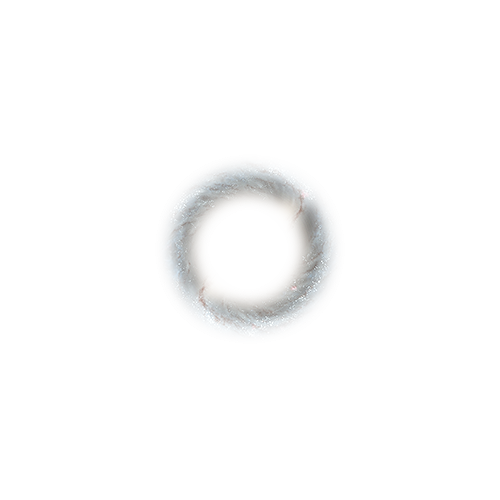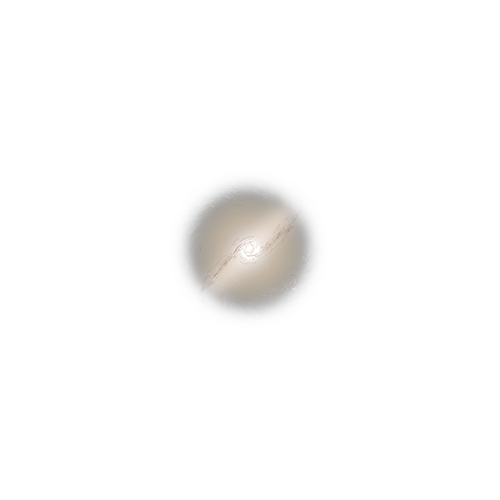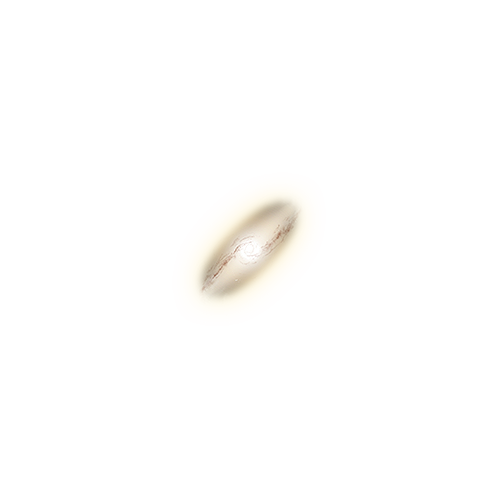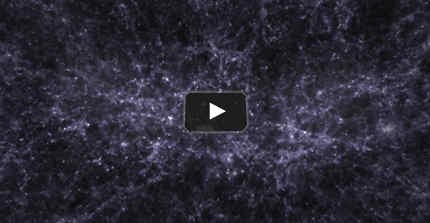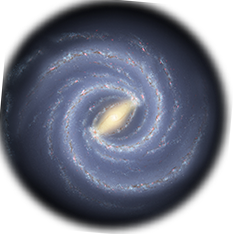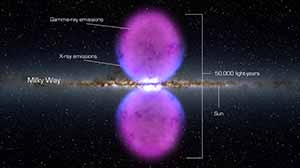
"It is now thought that most galaxies possess a central super-massive black hole!"

Animation © SkyMarvels.com
derived from NASA/GSFC SVS animation.
In CELESTIA you can orbit open clusters like the Pleiades! (1.6.x). Here it is with star names turned on! (1.6.x).
Globular clusters like OMEGA CENTAURI (1.6.x) & PAL 10 (1.6.x) are incredible! They can contain millions of stars in a region only 20-30 light years across!
Galaxies like M 31 (the Andromeda Galaxy) are like "island universes" containing millions to trillions of stars! (1.6.x). (Note: you can vary CELESTIA's galaxy brightness with the parentheses, ( and ) , for better viewing.)
Are you unfamiliar with our 1.6.x and 1.4.1 links? For an explanation click here.
DSO ACTIVITIES
MAKE A PINWHEEL
GALAXY PINWHEEL
No, we're not repeating our- selves unnecessarily at all. NASA's Space Place shows you how to create your own spinning spiral galaxy! Its Make a Pinwheel Galaxy Pin- wheel takes you through all the steps. Will yours be the Milky Way or Andromeda?
HELP "GALAXY ZOO"
CLASSIFY GALAXIES
There are so many galaxies that astronomers can't class- ify them all! You can help the tens of thousands of volun- teers worldwide who Help Galaxy Zoo Classify Galax- ies! You may help make a real discovery!
CELES-TIPS
The following will help you enjoy this page's 1.6.x and 1.4.1 links that run events directly in CELESTIA. If you're new to the program, these tips will also help you learn to use it.
- If CELESTIA's clock (i.e. the program's date and time) is not visible at the top-right of its window, press the V key until you see it. This will also turn on information text in other corners to help you keep track of several as- pects of the event you're viewing. Keeping an eye on CELESTIA's clock at the top-right will help you appreciate how much time is passing in each view.
- Pressing the "un-shifted" L key and K key respectively will speed up and slow down CELESTIA's flow of time by a factor of 10 in version 1.6.x and 1.4.1.
- Pressing Shift+L and Shift+K respectively will speed up and slow down CELESTIA's flow of time by a factor of 2 in version 1.6.x only.
- Pressing the J key (either shifted or "un-shifted") will reverse CELESTIA's flow of time in version 1.6.x and 1.4.1.
You'll find more information about many of CELESTIA's controls on our Learning Center page.
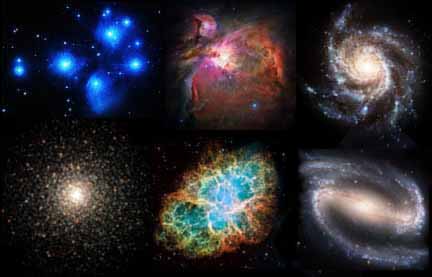
DEEP-SKY OBJECTS (DSO's)
STAR CLUSTERS, NEBULAE & GALAXIES
Rather than referring to ordinary star systems (singles, binaries, multiples) or to their subordinate components (planets, moons, asteroids and such), the designation "deep-sky objects" (DSO's) is typically used to refer to appreciably larger celestial groupings, formations or "collective" structures. They include the various types of star clusters, nebulae and galaxies.
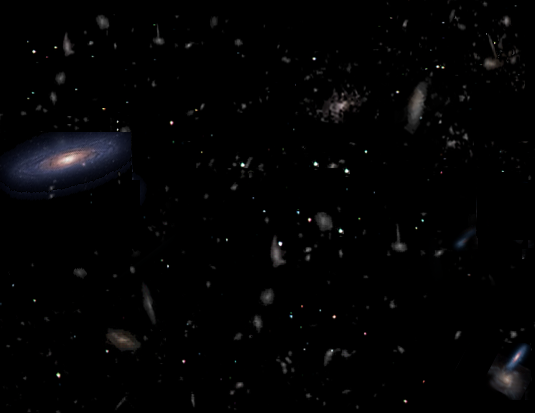
Today deep-sky objects rank among the most exciting and rewarding subjects in all of astronomy. In the first place, they have proved absolutely essential to our modern understanding of the true scale of the cosmos. Moreover, not only are they fascinating simply from the standpoint of physics, they are also among the most beautiful objects in nature!
The SEDS site's excellent Interactive Messier Objects page gives you quick acces to information about the most famous of the deeps-sky objects. In addition, the same site's Interactive NGC Catalog Online offers one of the best portals to information on thousands more deep-sky objects! Wikipedia's New General Catalogue and IC Objects pages are also good sources of related infomation.
STAR CLUSTERS
Star clusters are formations whose stars a.) essentially all developed approximately concurrently and b.) are all gravitationally bound so that they move through space together. The two primary types of star clusters, open clusters and globular clusters, have markedly different properties. SOL Cluster 3D Star Map ![]()
OPEN CLUSTERS
Often irregular in shape, open clusters (OC's) generally contain no more than a few hundred stars in a volume no larger than 2-3 dozen light years across. These are usually young stars with ages on the order of tens of millions of years. An overwhelming percentage of open clusters are found in or near the galactic plane, most in the galaxy's spiral arms, i.e. in the regions of greatest continuing star-formation.
Among the most prominent and regularly viewed open clusters are the Pleiades (M 45) (labeled) ![]() in Taurus, the Southern Pleiades (IC 2602)
in Taurus, the Southern Pleiades (IC 2602) ![]() in Carina, the Beehive Cluster (M 44)
in Carina, the Beehive Cluster (M 44) ![]() in Cancer, and the Ptolemy Cluster (M 7)
in Cancer, and the Ptolemy Cluster (M 7) ![]() in Scorpius.
in Scorpius.
An interesting interactive on Star Cluster Evolution.
Wikipedia's Open Cluster page.
GLOBULAR CLUSTERS
As their name suggests, globular clusters (GCs) or sim- ply "globulars" are dense concentrations of stars which gravity binds tightly into roughly spherical shapes. Al- though most are no larger than many open clusters, a globular cluster can contain a truly staggering number of stars—hundreds of thousands to millions of stars!— in a region often less than 200 light years across! Can you imagine looking out at a star as near as Vega and seeing over a million other stars filling your view?
Use the slider below to "zoom in" on a typical globular. After zooming in and out, you may scroll to study the bottom-right quadrant of this densely packed region of space! You'll soon gain insight into the different colors of stars that populate it! Yes, that's a lot of stars!
In globular clusters the overwhelming majority of stars are red and yellow dwarfs that are very old, perhaps 90% of the age of the Universe! The only younger stars in globular clusters are the rare "blue stragglers", thought to continually form from matter ejected when some old stars inevitably collide with one another. Did you spot any blue stragglers when you zoomed in on this dense neighborhood of stars? Look closely! They're in there!
Almost all galaxies have been found to contain globular clusters, most lying well away from their inner regions. In a spiral galaxy most globulars are found above and below its main disk, spread out in the roughly spherical volume of the surrounding galactic halo.
The approximately 150 globular clusters that are part of the Milky Way are no exception. Scattered throughout the galactic halo, most are therefore found far above or below the immense sweeping arms that constitute the "great star factories" of the galaxy!
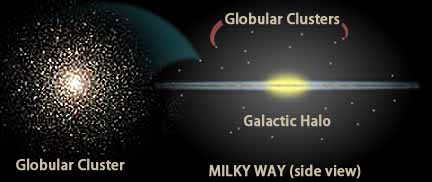
From RASC here is a good site that maps the Loca- tions of the Milky Way's Globular Clusters.
From NASA here is an Interactive Map of Several Milky Way Globulars.
Here is a truly awesome 3-D Model of a Globular Clus- ter. But note: Its 15,000 plotted stars are only a small fraction of what might be found even in average globular clusters! Still it does give an impressive sense of how densely stellar objects are packed into these relatively compact groupings. A few example globulars: M 15 ![]() , Omega Centauri Cluster
, Omega Centauri Cluster ![]() , M 79
, M 79 ![]() , M 80
, M 80 ![]()
Wikipedia's Globular Cluster page and List of Globular Clusters page.
INTERESTING STAR CLUSTER LINKS
For more information and some beautiful images of star clusters, here are links to NASA Hubble's Star Clusters, ESO's Image Archive Star Clusters page.
And here's a link to Wikipedia's Star Cluster page.
NEBULAE
Nebulae (or nebulas) are immense interstellar clouds of gas and dust. Some represent the regions of ongoing star production in the universe, while others are stellar "leftovers", discarded material which may one day help to spawn new stars. Some are remarkably stable, like diffuse nebulae, which if left undisturbed can remain essentially quiescent for hundreds of millions of years! Others, like protoplanetary nebulae, evolve relatively rapidly and represent a distinct phase in the waning lives of certain stars. NASA's Name That Nebula
CATEGORIZING NEBULAE
Nebulae are categorized in a number of different ways: a.) according to the nature of the light they give off or block, b.) according to the processes that produced or are producing them, and c.) according to their general shape and structure. It should be noted that a single cloud may be so large that various portions of it may be considered different types of nebulae. The famous Orion Nebula ![]() for example is customarily described as an emission nebula, though parts can certainly be regarded as reflective and dark nebulae.
for example is customarily described as an emission nebula, though parts can certainly be regarded as reflective and dark nebulae.
EMISSION, REFLECTIVE & DARK NEBULAE
Emission nebulae, as their name suggests, emit visible light, primarily from their ionized gases (especially hydrogen) and free electrons energized by ultraviolet radiation from nearby stars. These nebula are typically reddish, the color of hydrogen's dominant H II emission line. Named specifically for this are H II regions, which are of a type of emission nebulae where considerable star development is taking place and where massive, young stars are ionizing its gases. Example emission nebulae: Tarantula Nebula ![]() , Trifid Nebula
, Trifid Nebula ![]()
In reflection nebulae, the radiation from close-by stars does not possess enough energy to ionize their gases. Still, sufficient radiation is scattered to render them visible. Due to their inherently reflective nature, these nebulae typically share the spectrum of the stars that illuminate them. Example reflection nebulae: Witch Head ![]() , NGC 1999
, NGC 1999 ![]() , N30B "Double Bubble"
, N30B "Double Bubble" ![]() .
.
In some cases, portions of an interstellar cloud block essentially all of the visible light coming from "behind" them. These formations are called dark nebulae, and they can be found "in front of" emission and reflection nebulae, and even "in front of" simple fields of stars. Example dark nebulae: Horsehead Nebula ![]() , Cone Nebula
, Cone Nebula ![]() , Coalsack
, Coalsack ![]() .
.
DIFFUSE NEBULAE
Most nebulae are diffuse nebulae. These are generally spread out and irregularly shaped, often to the extent that distinct boundaries are difficult to define. Diffuse nebulae can be emission, reflection or dark nebulae, or any combination of thereof. For instance, the Orion Nebula ![]() referenced above as predominantly an emission nebula is likewise a diffuse nebula.
referenced above as predominantly an emission nebula is likewise a diffuse nebula.
PROTOPLANETARY NEBULAE
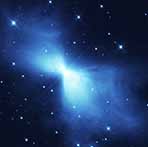 Protoplanetary nebulae are among the "worst-named" objects in all of astronomy! Not to be confused with protoplanetary "discs", accretion discs that form around developing young stars, protoplanetary nebulae form during a relatively brief phase late in the lives of medium-mass stars. After such stars ultimately swell to become red giants, but before they produce conventionally more-spherical "planetary" nebulae, their lower-energy radiation can shape their ejected envelopes, which essentially become reflection nebulae. Eventually an aging star's directional stellar winds may "sculpt" its ejecta into lobes and, when the star radiates in the ultraviolet, its protoplanetary nebula becomes an emission nebula. Example protoplanetary nebulae: Boomerang Nebula
Protoplanetary nebulae are among the "worst-named" objects in all of astronomy! Not to be confused with protoplanetary "discs", accretion discs that form around developing young stars, protoplanetary nebulae form during a relatively brief phase late in the lives of medium-mass stars. After such stars ultimately swell to become red giants, but before they produce conventionally more-spherical "planetary" nebulae, their lower-energy radiation can shape their ejected envelopes, which essentially become reflection nebulae. Eventually an aging star's directional stellar winds may "sculpt" its ejecta into lobes and, when the star radiates in the ultraviolet, its protoplanetary nebula becomes an emission nebula. Example protoplanetary nebulae: Boomerang Nebula ![]() , Red Rectangle Nebula
, Red Rectangle Nebula ![]() , Rotten Egg Nebula
, Rotten Egg Nebula ![]() .
.
Note: you will still find texts that treat protoplanetary nebulae and planetary nebulae as a single class, though they are now considered two distinct categories.
PLANETARY NEBULAE
A planetary nebula is an expanding shell of gas that is expelled when a red giant finally dies. Surrounding the star's residual core, which continues to emit ultraviolet radiation, the nebulae is thus ionized and illuminated. So planetary nebulae are emission nebulae, and a good many of the most famous ones have a ring-like shape. Still, most are actually more complex in form. Example planetary nebulae: Ring Nebula ![]() , Bug Nebula
, Bug Nebula ![]() , NGC 2440
, NGC 2440 ![]() , Cat's Eye Nebula
, Cat's Eye Nebula ![]() , Helix Nebula
, Helix Nebula ![]() .
.
SUPERNOVA REMNANTS
Supernova remnants are nebulae that are the "cosmic leftovers" of high-mass stars. A supernova explosion produces an expanding envelope around its residual core, which may be a neutron star (at times a pulsar), a quark star (theorized), a black hole or a white dwarf. Though similar to planetary nebulae in certain ways, supernova remnants are not nearly as numerous. This is because the stars that produce them are far more rare. Example supernova remnants: Crab Nebula ![]() , Cassiopeia A
, Cassiopeia A ![]() , LMC N 49
, LMC N 49 ![]() .
.
INTERESTING NEBULAE LINKS
From NASA's HubbleSite and GoogleArts, here is the Orion Nebula Image Tour.
For more information and beautiful pictures of nebuale, here are links to NASA Hubble's Nebulae, ESO's Image Archive Nebulae page.
And here's the link to Wikipedia's Nebula page.
GALAXIES
Galaxies are immense conglomerations of star systems, nebulae, interstellar matter and energy, bound together by gravitation. Huge in themselves, these vast amalga- mations, often aptly described as "island universes", are arranged throughout deep space in even larger galaxy clusters ![]() and superclusters! These are the "building blocks" of the unfathomably large galaxy filaments
and superclusters! These are the "building blocks" of the unfathomably large galaxy filaments ![]() , which stretch throughout the universe in incredibly com- plex 3-dimensional webs and networks!
, which stretch throughout the universe in incredibly com- plex 3-dimensional webs and networks!
Galaxies are generally classified according to shape as elliptical, spiral or irregular, most ranging in size from a few thousand to a half million light years across. This Galaxy Size Comparison Chart, showing the Milky Way at its center, begins to give us an idea of how varied the sizes of galaxies can be.
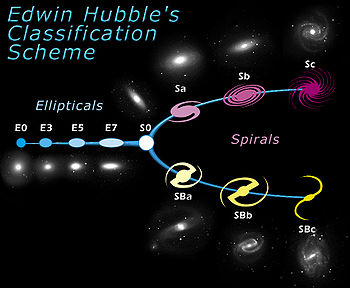
Here is an excellent interactive from ESA's Herschel Space Observatory mission that highlights the Major Classifications of Galaxies ![]()
From the SPITZER Space Telescope site, here is a high-resolution poster of the SPITZER Infrared Nearby Galaxy Survey (SINGS) Hubble Tuning Fork ![]()
From the famous Hubble Ultra Deep Field ![]() photo, we now know that, in the observable universe, there are over 100 billion galaxies! To give us an appreciation of just how many galaxies that is, below is an excellent Sloan Digital Sky Survey video that accurately shows where 400,000 galaxies lie in relation to one another. However, this is only a tiny fraction of all galaxies! The latest observations suggest that the Universe holds over a million times that number! And each galaxy contains millions to trillions of stars!
photo, we now know that, in the observable universe, there are over 100 billion galaxies! To give us an appreciation of just how many galaxies that is, below is an excellent Sloan Digital Sky Survey video that accurately shows where 400,000 galaxies lie in relation to one another. However, this is only a tiny fraction of all galaxies! The latest observations suggest that the Universe holds over a million times that number! And each galaxy contains millions to trillions of stars!
Here is a NASA video that shows the Eventual Collision and Merging of the Milky Way and Andromeda Galaxies.
OUR HOME GALAXY, THE MILKY WAY
Even as late as the 1920's, our own galaxy the Milky Way was believed to constitute the entire cosmos! But we now know that the universe is incredibly larger than was once believed! Current evidence indicates that the Milky Way is roughly 100,000 light-years across. Though this is but a tiny fraction of the entire universe, it is still immense by any earthly standards.
Structurally, the Milky Way is a barred spiral galaxy. Our Solar System lies in one of its spiral arms (the Orion Arm) about 28,000 light years from its core, as you can see in NASA's Annotated Roadmap to the Milky Way.
From the SPITZER Space Telescope site, it's New 360° Infrared View of the Milky Way may be viewed interac- tively and in high resolution with the Aladin Viewer or the WorldWide Telescope Viewer ![]() .
.
The animation below shows what the Milky Way looks like "from the outside"!
In addition, NASA's Fermi Gamma-ray Space Telescope has recently revealed immense bubble-like gamma-ray-emitting structures ![]() above and below the plane of the Milky Way's disk! These seem to be beyond the visible spectrum and extremely tenuous. While the origins of these structures are unknown, it has been suggested that they are related to the super-massive black hole at the center of our galaxy.
above and below the plane of the Milky Way's disk! These seem to be beyond the visible spectrum and extremely tenuous. While the origins of these structures are unknown, it has been suggested that they are related to the super-massive black hole at the center of our galaxy.
And here are links to Wikipedia's Milky Way and Orion Arm pages.
OUR LOCAL GROUP OF GALAXIES
Our Local Group of Galaxies consists of more than 50 gravitationally bound galaxies nearest to our own, all within roughly 5 million light years. This includes the Large and Small Magellanic Clouds, the Andromeda (M31) and Triangulum (M33) galaxies, and many smaller (dwarf) galaxies. In the two maps below, notice how the smaller galaxies are not spread uniformly through space but rather they cluster around Andromeda and the Milky Way.
Here are a few links to the Encyclopaedia Galactica's superb isometric Map of Our Local Group of Galaxies and Map of Our "Extended" Local Group of Galaxies.
BEYOND OUR LOCAL GROUP
Beyond our Local Group, galaxies have been found to be arranged in gigantic galaxy clusters of thousands or more members. Beyond this, the clusters stretch out to form long intertwining webs or filaments ![]() . This is the opposite of the prevailing theories of galaxy distribution just a half-century ago, when galaxies were believed to be dispersed rather uniformly throughout the universe! A lot has been learned since then. For example, quasars were once believed to represent an entirely different class of celestial objects than galaxies. Now they are thought to be highly active galactic nuclei!
. This is the opposite of the prevailing theories of galaxy distribution just a half-century ago, when galaxies were believed to be dispersed rather uniformly throughout the universe! A lot has been learned since then. For example, quasars were once believed to represent an entirely different class of celestial objects than galaxies. Now they are thought to be highly active galactic nuclei!
INTERESTING GALAXY LINKS
For more information and some beautiful pictures of star clusters, here are links to NASA Hubble's Galaxies, ESO's Image Archive Galaxy page.
And here's the link to Wikipedia's Galaxy page.
Home Intro News Gallery Sky-Gifts Bonuses Tips
Learning Ctr Help Links Credits Legal Contact Us
© 2007-
by Gary M. Winter. All rights reserved.
Interested in political cartoons and humor?
Check out The HIPPLOMATS™.
SkyMarvels, Sky Marvels, SkyMarvels.com, DEEP SKY OBJECTS! DSO's! Galaxies, Nebulae, Nebulas, Globular Clusters, Star Clusters. celestia4all, celestiaforall, CELESTIA, astronomy, space, simulations, animations, downloadable astronomy posters, stars, planets, Inner Planets, Outer Planets, Inferior Planets, Superior Planets, moons, asteroids, comets, Oort Cloud, galaxy, galaxies, Milky Way, Andromeda, globular clusters, binaries, quasars, black holes, supermassive black holes, telescope, telescopes, planetarium, software, freestuff, satellites, add-ons, addons, scripts, eclipses, Solar Eclipses, Lunar Eclipses, Solar Eclipse Finder, Lunar Eclipse Finder, mutual eclipses, transits, occultations, Solar System, CELES-TOOLS, celeSTARrium, CELX, CELX programming, Freebies, Bonuses, multiple views, atronomical unit, light year, parsec, meteors, meteor showers, Perseids, Geminids, Leonids, barycenter, time, Time Zones, tides, alignments, conjunctions, oppositions, seasons, apogees, perigees, aphelion, perihelion, Earth, Luna, Mercury, Venus, Mars, Jupiter, Galilean Moons, Io, Europa, Ganymede, Callisto, Saturn, Titan, rings, Uranus, Neptune, Triton, E-MSpectrum, electromagnetic spectrum, astronaut, equinoxes, solstices, precession, rotation, spin, inclination, tilt, Ecliptic, orbits, ellipse, parabola, hyperbola
Donate safely with: PayPal
and receive one or more
Sky-Gifts. Your support is greatly appreciated!
NOTE: you do not need a PayPal account to donate.
"A truly amazing video:
a flight through 400,000
Deep Sky Objects!"
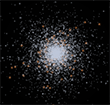
Orbiting a Globular Cluster
© 2013 SkyMarvels.com
SKY VIEWING
SOLAR SYSTEM
THE SUN
MERCURY
VENUS
EARTH
THE MOON
MARS
JUPITER
SATURN
URANUS
NEPTUNE
SMALLER WORLDS
STELLAR OBJECTS
EXOPLANETS
DEEP-SKY OBJECTS
SCALE OF THE COSMOS
———————
SKY-FUN / SKY-GAMES
FUN FACTS ABOUT
DEEP-SKY OBJECTS
Though some people report seeing farther objects when viewing is exceptional, the Andromeda galaxy, M 31, is generally considered to be the farthest object normally visible to the naked eye! It's about 2½ million light-years away!
M 1, the Crab Nebula, is the remnant of a supernova explosion observed here on Earth in 1054!
The Omega Centauri cluster has a mass of over 4 million Suns!
The largest known galaxy is IC 1101. It has a diameter 50 to 60 times greater than the Milky Way's and a mass in excess of 100 trillion stars!
DSO INTERACTIVES
QUICK ACCESS LIST
Note: some links are echoed elsewhere on this page and may include descriptive text. Note too that there are a few links to interactives in the center column immediately next to this list, so they are not duplicated here.
SEDS site's Interactive Messier Objects page
3-D Model of a Globular Cluster
Herschel's Major Types of Galaxies ![]()
Hubble's Hubble Ultra Deep Field. Lower on that page expand the Worldwide Tele- scope view.
ViewSpace: Interacting Gal- axies
Receding Galaxies. Zoom out and drag galaxies' view.
Cosmic Web Visualizations ![]() Select a Newtork Model, then pan, zoom and filter.
Select a Newtork Model, then pan, zoom and filter.
SKYMARVELS™
CELESTIA ADD-ONS
SKYMARVELS™ POSTERS
SKYMARVELS™ VIDEOS
Solar Eclipses:
Lunar Eclipses:
Moon's Occultation of Venus 2010 May 16
Moon's Occultation of Venus 2010 Sep 11
The Same Side of the Moon Always Faces Earth

